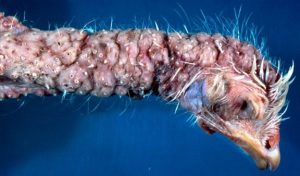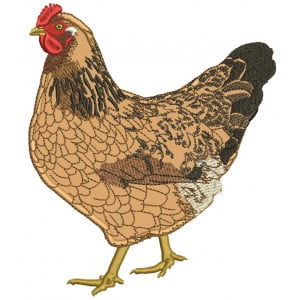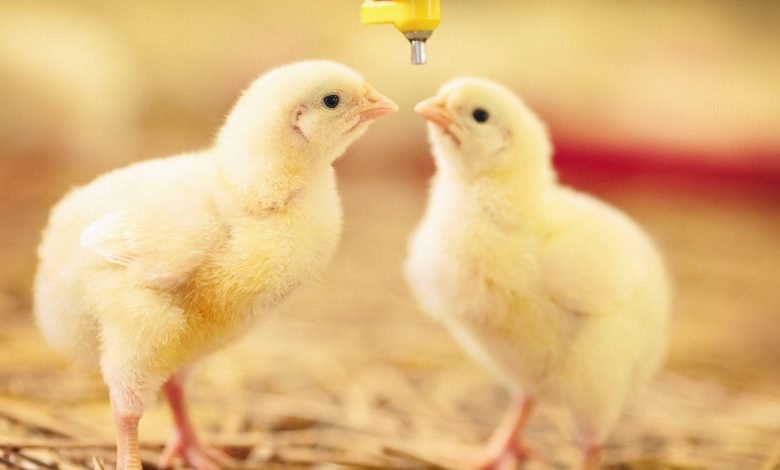
Dermatological disorders (Skin problems) in chicken: causes and solutions
Prof. R.N.S.Gowda
The skin or epithelial tissue of an animal provides a physical barrier between the animal and its environment, protecting the animal from bacteria and physical injury. In the case of poultry, if the integrity of the skin is challenged, the health of the bird can be compromised, and the value of the end-product can dramatically decrease.
Skin is the largest organ of animal body. The skin is an essential organ and plays an important role in thermal (heat exchange), hygrometric (water vapor exchange), and chemical regulation in bird physiogy. Bird’s skin differs from that of mammals by its thinness, by the presence of feathers instead of hair, and by the absence of sebaceous glands (sweat glands), although the overall histological structure is similar. Bird’s skin is composed of an epidermis separated from a dermis by a basal membrane. Its function is to protect the body from infection.
The integumentary system consists of the skin, the feathers and the appendages (claws and beak). The skin covers the majority of the body and contains glands in the outer ear canal and the preen gland at the base of the tail, that the bird uses to preen its feathers. The integumentary system is very important in providing protection to the bird from a number of potentially dangerous situations. The functions provided by the integumentary system include:
- A barrier between the external environment and the internal systems and organs thus provides support and protection from infection by microorganisms and from physical injury.
- Excellent thermal insulation to help regulate body temperature in a variable environment.
- Numerous nerve endings for the senses to enable the bird to be aware of potentially harmful situations.
- Pigments for display and protection from the elements.
- The compounds capable of conversion into vitamin D when exposed to sunlight.
Anatomy of the skin
Avian skin is relatively thin with the epidermis consisting of only 2‐10 cell layers. The dermis has a rich blood supply especially in more specialised area of skin such as the wattles. Beneath the dermis is elastic tissue and connective tissue which allows movement and attachment of underlying structures, but compared to mammalian skin is quite closely attached to these, making it relatively immobile. There are no sweat glands; instead heat is lost via the respiratory tract and by radiation from featherless areas. The brood patch is a featherless area that can occur in both sexes and is either seasonal or permanent depending on species. The feet have shield‐like plates of keratin named scutes. The foot has various digital pads to aid grip. The uropygial gland or preen gland is bilobed gland that secrets lipoid sebaceous material that is spread by the beak over the plumage during preening. The gland lies dorsally near the tip of the tail.
Structure
The skin is mainly composed of two different tissues:
- Connective tissue of the dermis and hypodermis where the cells are widely spaced.
- Cellular stratified epithelium of the epidermis, which make up the horny outer layer of the skin and forms the feathers.

Feathers
Feathers function not only to facilitate flight but also insulate, waterproof and protect the bird. Courtship, camouflage and display are other functions. Feathers are keratinized epidermis derived from follicles in the dermis. They are set in feather tracts known as pterylae, and the feather less tracts between the mare known as apterylae.
Moulting
New feathers developing in the dermal papilla force the shedding of old feathers above it. The shedding and replacement of feathers occurs at least once a year usually after breeding but can occur more frequent or purposeful moulting.
Factors affecting moulting:
- Nutritional deficits such as hypovitaminosis A
- Reduced protein levels result in poor feather condition and ‘fret marks’.
- Stress or fear can induce a stress moult.
- Reduction to shorter periods of light (especially after prolonged periods of light) induces moulting (through stimulation of the pituitary gland).
- Ectoparasites can cause abnormal moulting patterns.
- Hypothyroidism leads to retardation of feather growth.
Factors Impacting Skin Lesions in Poultry
There are several factors that can impact the integrity of the skin in a poultry operation and lead to scratches, such as stocking density, nutrition, type of equipment in the broiler house and handling during capture and processing. Once a scratch occurs, the bird is more susceptible to a bacterial infection. This can impact the overall wellness of the bird and result in a total carcass condemnation.
Dermatologic disease is sporadic poultry, and most commonly involves trauma and ectoparasites. Other infectious skin diseases can occur, but are less frequently encountered in poultry flocks. Skin quality is affected by a number of husbandry factors, including diet and sanitation. Research has focused on the effect of bedding type, size, and moisture on the development of footpad dermatitis in broiler chickens
A number of infectious diseases specifically target the integument; in others, skin is secondarily affected. The incidence of many can be reduced with ideal management practices, including proper nutrition, sanitation, and by avoiding overcrowding and exposure to predators etc.
| Skin and Feather Disorders of Pet Birds |
|---|
| Feather Cysts. |
| Feather Plucking. |
| Skin Infections. |
| Parasites. |
| Psittacine Beak and Feather Disease (Circovirus) |
The most common dermatological issues in chicken are:
- Abnormal feathers
- Irregular feathers
- Fragile skin
- Blisters
- Tumors
- Cut wounds
- Cellulitis (subcutaneous inflammation)
- Contact dermatitis
- Oily bird syndrome (scald damage)
- Breast blisters
- Scabby hip syndrome
- Pale or yellow skin
Non Infectious causes
What causes dermatitis in chickens?
Dermatitis in broilers is caused by a combination of moisture and chemical irritants like ammonia in the litter material during natural decomposition. These conditions affect areas of the skin greatly exposed, like the feet, hocks and breast.
Footpad dermatitis (FPD) is also called paw burns, ammonia burns or pododermatitis. This disease has gained importance due to the value of chicken feet as a profitable export item to Asian markets. Nowadays, broiler feet have become one of the most profitable parts of the carcass for export. Additionally, FPD has become a welfare concern since it affects broiler ability to walk and reduces feed intake and growth. The evaluation of FPD incidence is now part of many welfare audits. It is desirable to have less than 30 per cent of the flock with feet lesions but it is difficult to achieve this goal.
When the skin infection occurs through cuts in the skin of the feet, a plantar abscess with a very large inflammatory component may develop (bumblefoot).
What does dermatitis look like in chickens?
Lesions on the skin are dark reddish to purple to green. These are most often on the abdomen, breast, wings, and/or legs. Gas or gelatinous fluid may accumulate under the skin (Breast blisters). The bird’s skin may have a “spongy” feel to it because of increasing numbers of bacteria producing gas between the muscle and skin.
Dermatitis with cellulitis : dermal carcinomatosis, skin tares, scabby hip, and breast blisters are the most frequent ones. However, the permanent increasing dermatitis with cellulitis as well as the frequency rank following dermal carcinomatosis are of utmost importance.
Nutritional supplements help healing process of skin
Rapidly dividing cells, such as those of the epidermis or skin, are dependent on zinc to provide a strong skin or epithelial barrier to protect against bacteria and physical damage. Ninety percent of the cells found in the skin are called keratinocytes, the predominant type of cell in the epidermis. Keratinocytes form the outermost layer of cells that protect animals and humans from environmental challenges. When a pathogen invade the outer layer of the epidermis, keratinocytes react by producing pro-inflammatory mediators, which attract leukocytes to the site of pathogen invasion helping to fight the infection challenge and heal the site.
Infectious causes
Contact dermatitis in domestic poultry.
Contact dermatitis is a common finding in commercial poultry kept for meat production that has both economic and welfare implications. The disease commonly affects the epidermis of the foot pad, hock joint and skin covering the breast muscles that are in contact with the litter or other floor materials.
Bacterial
Staphylococcal infection of poultry: This infection is commonly associated with infection of skin, bones, joints, and navel. There is a potential risk for human food poisoning.
Etiology : Staphylococcus aureus is the most common species that causes disease in poultry. However, other species may also be found. Among the most frequently isolated species are S. lentus, S. simulans, S. cohnii, S. gallinarum, and S. capit
Pathogenesis: Most species of Staphylococcus are considered benign organisms on skin and mucosal membranes. Coagulase positive isolates of these bacteria are considered pathogenic for poultry. The pathogenesis and port of entry of these bacteria have not been completely understood. It is almost certain that bacteria can gain entry inside tissues through cuts, lacerations, scratches, injections contaminating the skin (localized abscesses, cellulitis, and also often contain bacterial organisms such as E,coli, pseudomonas, acronomas spp, citrobacter spps p. multocida)’
localized abscess or diffuse cellulitis may develop with the accumulation of purulent exudate. Consequent to IBD and Chicken Anaemia immunosuppressed birds, the dermal infection may progress to a gangrenous dermatitis.
Gangrenous dermatitis (GD)
GD is characterized with nercotization of different skin areas and a severe cellulitis of the subcutaneous tissue. The sudden and quick increase in death rates is often the first signal for the incidence of GD. The affected birds die after less than 24 h. The death rate is from 1% to 60%. The lesions are dark red to blue green macerated skin areas, usually featherless, beginning generally from wings and the adjacent areas.(see fig.2)
Most outbreaks are encountered in broilers at the age of 4 – 8 weeks. The disease is also observed in stock layer hens at the age of 6 – 20 weeks and broiler parents at the age of 20 weeks. The outbreaks are frequently observed in extremely wet and warm premises. The gangrenous dermatitis affects birds while still alive. In more severe cases, the gangrene could begin and involve the skin of the head, neck and the breast. Affected skin is macerated or totally necrotic, resulting in exposure of underlying tissues in a number of cases.



Fig:2. dermatitis in chicken Haemorrhages in skin and muscles especially on the wings.
The Cause
The GD is caused by bacterial agents such as CI. Sep n ticum, CI. perfringens type A and Staphylococcus aureus, independently or in combination. The associated infection is more severe. The skin lesions are often crepitating and are detected in the regions of breast, abdomen, back or wings in both alive and dead birds.
What is blue wing disease?
Blue wing disease is consequent to Chicken Infectious Anaemia infection. It is an acute disease in chickens that causes high mortality in 2-3 week-old chickens. The major pathological lesions are Haemorrhages in skin and muscles especially on the wings, and gangrenous dermatitis and depletion of lymphocytes in lymphoid tissues; the thymuses being most severely damaged.
Pathogenesis

Fig 3. Unilateral blue wing disease showing wet, edematous, hyperemic skin and caking feathers in chick with gangrenous dermatitis.
Under natural conditions, immunosuppression can be triggered by a wide range of infectious and environmental factors in chickens. Immunosuppressive viral agents that may predispose to GD in chickens include Marek’s disease virus, infectious bursal disease virus, Chicken Anemia virus, several reoviruses, and reticuloendotheliosis virus. Other viral infectious agents such as inclusion body hepatitis virus in chickens also been suggested as possible immunosuppressive agents that may trigger GD. Severe lymphocytic depletion of the thymus and bursa of Fabricius, associated with the onset of GD because of immune suppressive diseases.
In broiler chickens, GD is mainly predisposed to by traumatic damage of the skin, usually associated with cannibalism and overcrowding. Such skin lesions provide a port of entry for bacteria and Chaotic multiplication of the intestinal flora followed by absorption into the bloodstream promoted bacteremia, which was thought to be the origin of some of the GD lesions. There is anecdotal evidence of a similar pathogenesis of GD in broiler chickens as a result of the use of ionophores in the feed associated with toxic muscle damage.
Clinical signs of gangrenous dermatitis
The disease can occur without clinical signs being observed. However, high fever, depression, anorexia, ataxia, leg weakness, and lateral recumbency are usually seen in both chickens. The lower abdomen and inner thighs are frequently affected by the accumulation of subcutaneous edema. The skin over affected areas is usually featherless and can show dark-red, purple, green, or green-blue discoloration (Fig. 2). The most frequently affected areas of the body are breast, abdomen, back, thighs, legs, and wings (Fig. 3)
Prevension
GD can be prevented or controlled to a great extent by preventing cannibalism, reducing overcrowding, providing a balanced diet, decreasing the intensity of light, good ventilation, controlling humidity, controlling ectoparasites, providing perches and dust bathing on the floor, beak and toe trimming, and cleaning and disinfection of houses between each flock placement.in cage system of raring the nails grow sharply and injure birds, toe clipping helps to prevent dermatitis problem.
Treatment
Gangrenous dermatitis has historically been treated effectively with administration of many broad-spectrum and gram-positive antibiotics. Water acidifiers have been used in cases to reduce, but not eliminate, mortality where mortality rates are low or antibiotic efficacy has been poor. However, a combination of clindamycin or tetracycline appears to be more effective.
Erythromycin,0.102g/ml for chicks, 0.25g/litre for adult birds in drinking water help in treatment.
Ulcerative dermatitis
Ulcerative dermatitis of brown cage-free layers is a problem that has been reported in some western countries since 2014. It has impacted various companies, but only brown layers. It results in high mortality. “The birds get an ulcer right in the middle of their back, and we’re not sure how it starts,”. It starts out small and gets bigger, like a flesh-eating bacterium. Rodents, insects, chemical irritants and wounding have all been ruled out as the cause. Antibiotics and disinfectant powders were not successful in helping with the issue. As the open area gets worse, the birds end up dying of E. coli.
Skin Tumors
Marek’s Disease(MD) affects chicken breeds for meat production and those for egg production, even though these two types of productions may not be equally affected in some countries due to breeding practices. It is also called as skin leucosis or cutaneous leucosis/ cutaneous MD.
Macroscopic and microscopic lesions have been observed on the skin of infected chickens at the feather follicles or near them. Two types of lesions have been found: tumor-like and non tumor-like lesions. It is noteworthy that it was the tumor-like cutaneous lesions (often incorrectly called cutaneous leucosis) observed in the slaughterhouse that led to the initial suspicion that the skin was the main infected tissue in MD.
Birds presented hypertrophied feather follicles with compact lymphoid aggregates in the dermis associated with capillaries upon microscopic examination. The presence of MDV in tumor-like lesions was subsequently confirmed by isolation of the virus in culture.
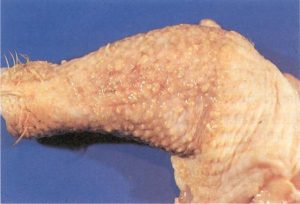
Fig:4. Cutaneous MD, enlarged feather follicles of leg and neck,
Skin leucosis: Noted in broiler chicken on postmortem examination as enlargement of feather follicles and associated lymphoid infiltrations. Enlarged feather follicles (commonly termed skin leucosis) may be noted in broilers after defeathering during processing and are a cause for condemnation.
Bumble Foot
Other names: Pododermatitis, Foot pad dermatitis, paw burns,Ulcers
Bumble foot: is a bacterial infection that enters the poultry’s foot through a wound, sets up wound , and ends up causing a slow, painful death if it is not treated.
Footpad dermatitis (FPD): is a type of skin inflammation that causes necrotic lesions on the plantar surface of the footpads in commercial poultry, with significant animal welfare, and economic implications.
Fig:5.Development of foot pad dermatitis.
Fig:6. Causes of foot pad dermatitis, infectious, management and nutritional
Cause: infectious:
Bumble foot in poultry is often caused by a staph infection that develops in an open wound on their feet. Sometimes a small cut on your chicken’s foot from scratching or cage wound is enough to invite infection into the body. A dirty cage, overcrowding creates a prime condition for the growth of harmful bacteria that leads to this disease. In addition to small cuts caused by everyday wear and tear, there are a few causes of injury(fig.6)
Clinical signs
Brown black scab on the bottom of the feet, discolouration, swelling, lameness, reluctant to move, and Behavioural changes.
Fig:7. Different grades of development of foot pad dermatitis
Limping, Red Bumps or Sores on Feet, Swollen feet, Fatigue, Decrease in Appetite, Plug-like Black Scabs on Bottom of Feet.
Prevention of Bumble Foot Chicken
Prevention of bumble foot is best done by taking preventative measures right from the beginning to ensure that chickens are not at risk for developing this foot condition.
- Keep chicken cages clean and dry.
- Regularly check for any signs of injury or foot problems in birds, especially if they spend most of their time on hard surfaces like wires.
- Trim the chicken’s wings to keep it from flying over, putting it at greater risk of injury.
- Trim the sharp points on cages to prevent injuries when birds.
- Make sure there is no debris or sharp objects in chicken fencing that can injure their feet.
- Feed chickens a high-quality diet that includes plenty of fresh greens and clean water daily.
- Diversify a chicken’s activities for the day
- Do not allow chickens to fly and roost over hard surface
Treatment
Treatment should be based on culture and sensitivity(both aerobic and anaerobic) of the infected area. Most commonly used antibiotics include cephalosporins, fluoroquinalones, lincomycin and clinidamycin. Enrofloxicilin and chlomphenical are often good choices.
Cutaneous Fowl Pox
Avian pox is a highly contagious viral disease caused by avipox viruses (family Poxviridae, subfamily Chordopoxvirinae) that has been documented in more than 230 species of birds worldwide.
Fowl pox virus causes crusty and nodular lesions primarily on the unfeathered portions of the bird. Occasionally, poxvirus can cause lesions in the mouth and trachea, causing death due to suffocation (wet form). If the bird recovers, immunity is generally lifelong.
Avipox virus infection is often slow to develop and manifests in both cutaneous and diphtheritic form. The most common cutaneous form is usually self-limiting and is characterized by wart-like nodules that occur around the eyes, beak and non-feathered skin. The diphtheritic form, also known as ‘wet’ pox, results in the formation of lesions on the mucosal membranes of the mouth and respiratory tract (throat, trachea and lungs) of infected birds, causing impaired breathing and difficulty in feeding.


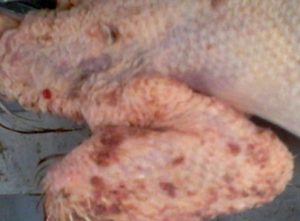

Morphology of skin lesions: Infected chickens manifested multifocal raised grey/tan, crusty, verrucous, irregular nodules on the skin around the eyes and comb. crusts and hyperplasia of the epidermis at the edges of the ulcers(fig8).
Prevension
By adopting a timely and good vaccination programme
Favus dermatophytic fungus
Favus is a chronic skin condition that afflicts poultry and mammals, including humans. It is normally caused by the dermatophytic fungus Trichophyton megninii. The fungi Microsporum gypseum, Mycosporum gallinae and Trichophyton simii have also been identified with some cases of favus. It is not considered a particularly important disease of intensive poultry, although it may be a problem in some free-range and backyard flocks.
The first symptoms include the development of lesions on non-feathered skin, such as the lower leg, comb and wattle. Some loss of feathers and skin scales may occur although there are normally no significant signs.
Control and Prevention of Favus
The condition normally only affects individuals within a flock, and spreads very slowly, by physical contact. Contamination of housing can occur, and so disinfection and the removal of infected individuals are important control measures.
PARASITES
External parasites such as mites and lice are common in poultry. Checking the flock periodically for external parasites and treating early helps prevent a larger flock outbreak.
Mite and Lice: Mites and lice are external parasites that can cause skin problems.
Lice, mites, fowl ticks, and chiggers — are the creepy-crawlies found on the outside of the chicken, so common that earlier poultry tenders didn’t even bother treating chickens for them. That said, these pests can cause anemia, damaged feathers, weight problems, poor laying, or — in young birds — death.
Body lice may build up huge populations on birds. Large infestations can cause loss of body weight and a significant drop in egg production. The entire life cycle can occur in as little as 3 weeks. Lice eggs are laid in masses and stick to the base of feathers.
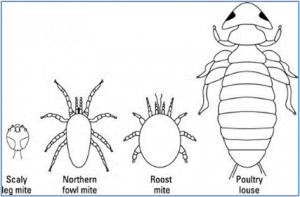


Scaly leg mites ( cnemidokoptes mutans): and depluming mites are occasionally found on flocks. Scalyleg mites primarily infest the legs and feet, where they tunnel in the upper layers of skin. A severe infestation causes a crusty outer covering on the legs and feet. Depluming mites burrow into the skin at the base of the feathers, causing infested birds to pull out their feathers.


Fig :10. Feather damage and lice eggs at feather root.
Sticktight fleas (Echidnophaga gallinacea) attach themselves to the skin and wattles on the head of birds. Unlike northern fowl mites or scaly-leg mites, these fleas can thrive on other animals, including dogs, cats, horses, and humans.
Fig:11. Stic tight fleas attached to comb and around eyes
Fowl tic : Argaspersicus is a soft tic wit oval shaped body a common ectoparasite of chicken
Fig12: Argaspercicus tic
Dermanyssus gallinae, the red mite, is probably the most common parasitic problem encountered by poultry keepers. It is easily spread by wild birds. Chicken mites are seldom a problem in caged-layer operations because there are few places to hide and lay eggs. They can be serious problems in breeder houses where nest boxes and slats offer ideal hiding places.
These mites may go unnoticed unless you examine the birds at night. Determining mite population levels on the birds is difficult because they scatter evenly over the bird. A better method is to examine cracks and crevices for mite presence.
External parasite treatment
| Pesticide | Effective against | Uses | Forms |
| Camphor | Scaly leg mite | Chicken’s legs and feet | Ointment |
| Diatomaceous earth (DE) | Lice, northern fowl mite, roost mite | Chicken, coop, dust bath | Powder |
| Garlic juice | Northern fowl mite | Chicken | Spray |
| Ivermectin | Lice, northern fowl mite, roost mite, scaly leg mite | Chicken | By mouth or injection, prescribed by a veterinarian |
| Neem oil | Lice, northern fowl mite, roost mite | Chicken, coop | Spray |
| Petroleum jelly/sulfur mix | Scaly leg mite | Chicken’s legs and feet | Ointment |
| Pyrethrin and permethrin | Lice, northern fowl mite, roost mite | Chicken, coop | Powder, spray, dip |
| Sulfur | Lice, northern fowl mite, roost mite | Chicken, coop, dust bath | Powder, spray |
Conclusion:
Skin problems in pouultry often caused by many etiological factors including non infectious and infectious causes. These may be abserved by keen supervision /observations in the farm and adoption of managemental, nutrition and disease control statagies as described.
(The author was former Vice chancellor, KVAFSU, Bidar, Karnataka ,Former Director IAH&VB, Bangaluru, Former Prof &University Head, Department of pathology, Veterinary College, UAS, Bangalore)


